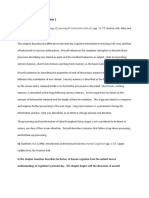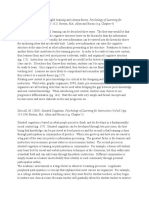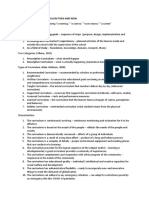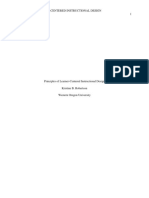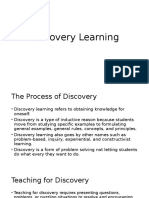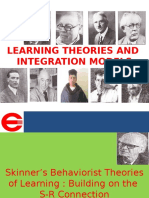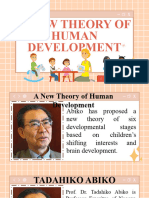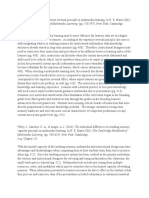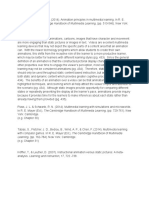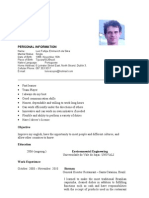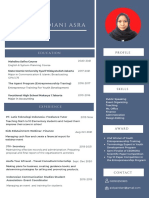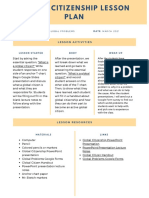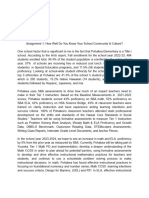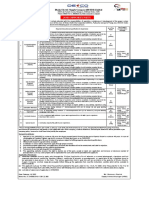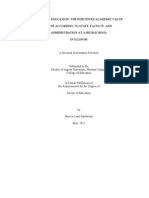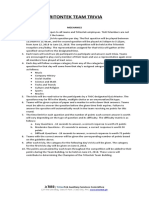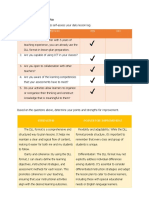#1 Driscoll, M. (2005). Psychology of Learning for Instruction (3rd ed.) (pp. 71-77).
Boston,
MA: Allyn and Bacon.
Sensory memory is the first stage of information processing which includes visual and auditory
function as temporary containers. The second stage is the working memory or short-term
memory which additional processing is carried out to make information ready for long-term
storage. The last stage is the long-term memory which represents a permanent storage container
that will never reach a maximum information limit.
For example, throughout the stages of sensory memory, short-term memory, and long-term
memory my students would begin to improve a previously construct science investigation based
on the shadow of a tree and the time of day.
First of all, during the sensory memory stage they were to read and respond to a lab journal in
which the science student recorded data, information, and conclusions to the movement of a
shadow throughout the day. So as they read the journal entries they had to recall occasions when
they could see their shadow.
Next, students were asked to analyze the journal for correct lab procedures and incorrect or
missing lab parts/procedures as partners. At this point students were in the short-term memory
stage because they were asked to rehearse and chunk pieces of the investigation that were
properly performed from the missing pieces.
Finally, the parts of an investigation were listed and discussed as a whole group. At this point
students were in the long-term memory stage because the scientific method/science and
engineering practices are taught and performed throughout the science curriculum. Which in
turn, then the assignment began because they were then asked to design their own investigation
that they would conduct that filled in the missing parts/procedures.
#2 Guenther, R.K. (1998). Introduction and historical Overview.Human Cognition (pp. 1-27).
Upper Saddle River, NJ: Prentice Hall.
Human cognitive psychology is how people accumulate and use knowledge, in which mental
processes reflect physical processes. The emergence of the natural perspective refers to the
physical inorganic universe became natural and humankinds place in that universe became
ordinary.
Vitalism means that life requires the presence of a life force whose nature is not physical but
spiritual. The theory of evolution is offspring of any species vary from one another and that only
�a small portion of the offspring ever survives into adulthood. (Natural Selection) Therefore,
mutations contribute to variability in a species, as well as environment plays a huge role in
evolution (Adaptations). All in all the extinction of one species plays a role in the origin of a
new species. Dualism reality is 2 parts: 1) ordinary matter that occupies space 2) doesnt obey
physical law or occupy space, has the capacity to think. Mind substance can exist independently
from the body. We can initiate action independently of bodily states or external stimuli. If the
mind can initiate actions on its own, independent of the body then this is the dissimilarity
between the mind and physical processes.
With the emergence of cognitive science, which states that the mind reflects only the physical
processes of the brain. In order for cognitive skills to evolve, individual members must show
cognitive variation. Behaviorism is environmental stimuli control behavior, and only external
stimuli and neural activity can cause behavior.
The mind is like the actions of a machine. Information-transmitting machines are that human
cognition has many of the properties of such machines. Information transformation examples:
telephones and computers. Humans have a limited capacity for storing and transmitting
information. Essential components of a computer have their functional counterpart in human
cognition. Computers are not like humans at all.
Neural Net Models have no program that controls what the model does and depends on the
current configuration of connections among its units:
Input units- action taking a sip of beer
Output units- correspond to making a decision
Hidden units- help the input find its output for different situations
(Additional) Reeves, A.R. (2011). Where great teaching begins. Instructional Design: Who and
What is it For? Alexandria, VA: ASCD.
A teachers job is not only as evaluators but to plan lessons according to what the students learn
and how they would learn it. Instructional design work goals are to design instruction that will
lead their students to achieve grade-level standards based learning goals. This is referred to as
deep-design which is to create instruction that distinguishes student-centered and learningcentered lesson planning from the classroom-centered planning.
Student- and learning-centered instructional designs focus is on the level of thinking students
will do, the academic skills students develop, the academic experiences students take away from
their classroom experiences, and that planning addresses long-term outcome. Even when scores
are good and above grade level most teachers can expand and evaluate their understanding of
their practice by asking the deep design questions.
�Another benefit of focusing on student learning and growth instead of the activities equals out to
effective time management. Teachers can save time when planning shifts from getting through
activities to thinking of the student learning that will take place. Smarter planning does not have
to take a longer period of time. Knowing the content standards and the instructional content is
providing students with long-term memory processing would be more effective when the
designers understands the short-term goals.
#3 Smith & Ragan (1999). Introduction to Instructional Design. Instructional Design (pp. 1-12).
New York: Wiley.
Designers must establish problem-solving procedures that provide guidance in the decision
making process when it comes to their designs. ALL plan what the solution will be like.
Classroom teachers implement their own plans.
Instruction should be deliberate facilitation of learning toward identified learning goals and a
planned arrangement of experiences. Education, training, and teaching interchangeably with
instruction. Instruction is a subset of education, and training a subset of instruction. Educational
activities that are instruction are: educational where all experiences are created for people to
learn because focused educational experiences are instruction, training where instructional
experiences are focused upon individuals acquiring specific job set skills that they will apply
immediately (Ex: business, military and government), and teaching refers to learning
experiences that are instructed by a human being.
3 major activities of the instructional design process are a type of problem solving. These
processes are different because of the level of accuracy, and knowledge that is involved in the
planning, development, and evaluation processes.
Goals (Perform and instructional analysis)
Strategy and medium (Develop an instructional strategy)
Assessments, evaluation, and revision (develop and conduct an evaluation)
#4 Smith & Ragan (1999). Foundations of Instructional Design. Instructional Design (pp. 1329). New York: Wiley.
Knowledge is not transmitted; it is constructed. There are several forms of knowledge they
are: individual constructivism knowledge which is constructed from experiences, empiricism
(objectivism) knowledge which is learned through experiences, and pragmatism knowledge
which is interpreted through reason and is temporary and tentative. Both philosophy and theory
provide foundations for instructional designers. Philosophies and theories may influence
educators views about what knowledge is and how it is attained.
�There are four major assumptions of instructional design and they include: the designer must
have a clear idea of the learner outcome as a result of the instruction; the greatest instruction is
real, effective, and interesting; students can learn from many different methods; principles of
instruction that apply to all age groups and all content areas. Therefore, theory is a prepared set
of statements that allows us to clarify, guess, or control events.
There are major theory bases that provide explanations for learning and instruction. Learning
theories attempt to describe, explain, and predict learning which describes how learning takes
place. A cognitive learning theory focuses on explaining the development of how the learner
should construct meaning from instruction. Learning occurs according to information processing
theory in which describes learning as a series of alterations of information through a series of
suggested structures within the brain.
